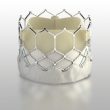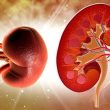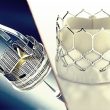TAVR has shown benefits in high risk patients (prohibitive) and in intermediate risk patients, but the need for permanent pacemaker implantation (PPI) continues to be a soft spot (especially in younger patients) given time of use, eventual replacement and associated complications. Even though there is little information on PPI, pacemakers are not associated with higher mortality, but they<a href="https://solaci.org/en/2018/04/04/permanent-pacemaker-still-tavrs-aquilas-heel/" title="Read more" >...</a>
Mild Leaks: TAVR’s Silent Enemies
Courtesy of Dr. Carlos Fava. Even though the presence of paravalvular regurgitation (PVR) has been reduced, thank to greater experience and new devices, it is still frequent and has an impact in survival (especially moderate and severe PVR). Recent research has shown that mild PVR also has a negative impact. However, these data were provided<a href="https://solaci.org/en/2018/02/15/mild-leaks-tavrs-silent-enemies/" title="Read more" >...</a>
Lung Disease and TAVR: Beneficial for a Reduced Group of Patients
Chronic Lung Disease often affects patients with severe aortic stenosis undergoing transcatheter aortic valve replacement (TAVR) or surgery. In fact, this is why patients with lung disease are often deemed inoperable and prescribed TAVR. This is the first time the benefit of TAVR has been assessed in this group of patients, for symptoms of these conditions can<a href="https://solaci.org/en/2017/11/21/lung-disease-and-tavr-beneficial-for-a-reduced-group-of-patients/" title="Read more" >...</a>
Here you will find the last news about TAVR
1) New Study Confirms TAVR Durability at 5 Years The ADVANCE study was designed to evaluate the safety and effectiveness of transcatheter aortic valve replacement (TAVR) with self-expanding prosthesis CoreValve in “real world” patients with symptomatic, severe aortic stenosis at high surgical risk. Read the conclusions of this study 2) An Important Study Shows That Renal Function Must Be Cared for in<a href="https://solaci.org/en/2017/11/15/here-you-will-find-the-last-news-about-tavr/" title="Read more" >...</a>
The SOURCE 3 Confirms the Good Outcomes of the SAPIEN 3 at One Year Followup
Transcatheter aortic valve replacement (TAVR) was developed as a strategy to treat non-surgical aortic stenosis, and was later expanded to elderly patients at intermediate risk, because of increased operator experience (overcoming the learning curve) and improved devices. The present study presents the one year outcomes of the SOURCE 3 trial, the multicenter European registry of the<a href="https://solaci.org/en/2017/10/27/the-source-3-confirms-the-good-outcomes-of-the-sapien-3-at-one-year-followup/" title="Read more" >...</a>
An Important Study Shows That Renal Function Must Be Cared for in TAVR
Courtesy of Dr. Carlos Fava. The presence of renal dysfunction in the “real world” is over 25% in patients who undergo transcatheter aortic valve implantation (TAVI). The evolution of this disease among patients who are subjected to a replacement is well known, but evidence for patients who undergo TAVI is still limited, particularly for those who<a href="https://solaci.org/en/2017/10/20/an-important-study-shows-that-renal-function-must-be-cared-for-in-tavr/" title="Read more" >...</a>
It Is a Fact: Cerebral Protection in TAVR Has Proved to Reduce Stroke and Death
Cerebral ischemic events after transcatheter aortic valve replacement (TAVR) have been identified as independent predictors of morbidity and mortality. New-generation devices have managed to partially reduce the rate of cerebral events, but it still is around 5.5% at 30 days for patients undergoing TAVR through transfemoral access. First data on cerebral protection devices had only shown<a href="https://solaci.org/en/2017/09/29/it-is-a-fact-cerebral-protection-in-tavr-has-proved-to-reduce-stroke-and-death/" title="Read more" >...</a>
Post TAVR Dialysis: a Severe Complication Less and Less Frequent
The prevalence of pre-procedural kidney failure in patients undergoing transcatheter aortic valve replacement (TAVR) can be as high as 50 – 60% (stage 3 kidney failure or worse); it has been strongly associated with acute kidney deterioration and, ultimately, an increase of post TAVR mortality. A recent meta-analyzis of several small studies carried out in a single<a href="https://solaci.org/en/2017/08/25/post-tavr-dialysis-a-severe-complication-less-and-less-frequent/" title="Read more" >...</a>
Lotus vs Sapien 3, different mechanisms with similar results
The new generation devices for transfemoral transcatheter aortic valve replacement have been optimized to improve valve position and reduce residual aortic regurgitation. This study compared 30 day, 12 month and 24 month outcomes of the repositionable, Lotus valve, with controlled mechanical expansion, and the balloon-expandable valve Edwards Sapien 3. Primary end point was all cause mortality<a href="https://solaci.org/en/2017/07/26/lotus-vs-sapien-3-different-mechanisms-with-similar-results/" title="Read more" >...</a>
Cerebral protection during TAVI still offers weak evidence, but there is hope
Silent ischemic embolic lesions are common after transcatheter aortic valve implantation (TAVI). The use of cerebral protection devices might reduce the occurrence of these embolic lesions. Multiple studies with different devices, designs, and outcomes challenge the usefulness of cerebral protection during TAVI. A comprehensive analysis of the literature was necessary to obtain a more<a href="https://solaci.org/en/2017/05/28/cerebral-protection-during-tavi-still-offers-weak-evidence-but-there-is-hope/" title="Read more" >...</a>









